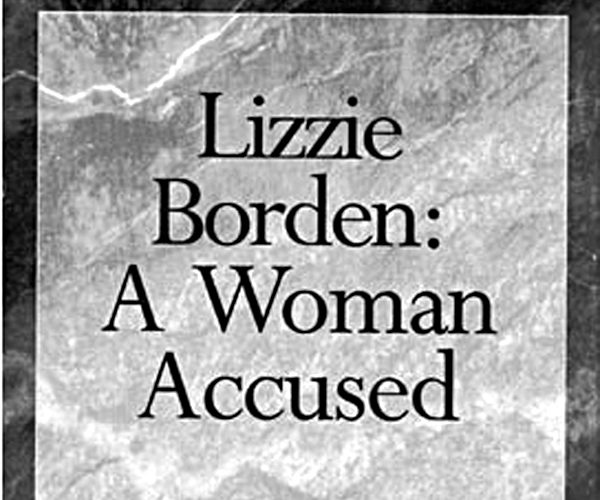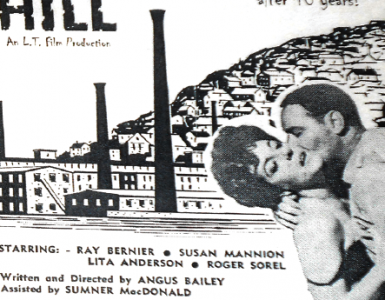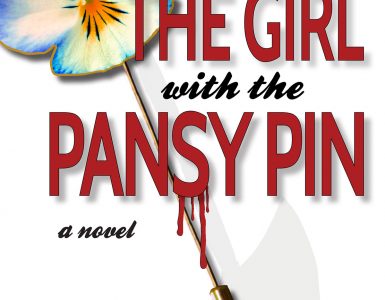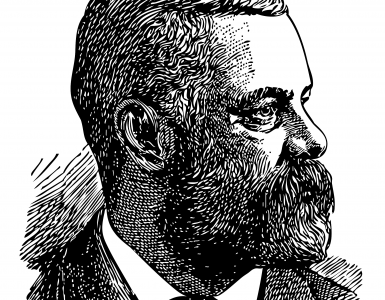by Eugene Hosey
First published in December/January, 2005, Volume 2, Issue 6, The Hatchet: Journal of Lizzie Borden Studies.
After viewing the recent “supernatural” television shows for the Halloween Season about the hauntings of 92 Second Street in Fall River, I was impelled by my wasted patience to review my collection and identify a television program on the subject of Lizzie Borden that I could genuinely appreciate and recommend to everyone. To meet that criteria, I went back 10 years and found some satisfaction in the 1995 A&E Biography, Lizzie Borden: A Woman Accused. The program is fact-driven, honest; and relatively speaking, remarkably undamaged by error. It does not have an agenda nor caters to a narrow audience. While it does not reveal startling findings to the seasoned enthusiast, it is an entertaining and comprehensive program. It has the objective integrity that is sorely lacking in sensational concoctions.
The Ghost Hunters and Scariest Places shows warrant a few critical notes. They both represent the supernatural sub-genre of the subject. The former program was perhaps honest in its zero findings, yet it was marred from the beginning by an apathetic, cynical attitude. The latter dove headlong into a ridiculous “reality-show” situation of unbelievable melodrama and feigned frights. The fact is I would rather see and hear for myself through a camera scrutinizing the house at midnight than watch a girl jumping and screaming in the guest room. There would seem to be the potential in both these shows, of course, to present a unique view, but it is hard to care when the investigators themselves are just going through certain motions — when apathy, phoniness, or outright silliness rules. When the group in Andrew and Abby’s room exclaimed they heard a cat screaming under the bed, I wondered how we were supposed to distinguish the superimposed sound effects from supernatural audio manifestation. And when one of them opened the closet door, I wanted to tell them that the door would close by itself if they would stand still and watch. Of course, the door is somehow off-center and won’t stay in an open position. But I could not help considering the irony that a shot of the door moving by itself would have a spooky effect, while at the same time the event would be completely real and unrigged. But this would have required observation in the first place, and they had a show to put on. If Abby’s ghost had greeted them, who would have noticed? A successful supernatural investigation would seem to need a special set of conditions and circumstances.
I recommend the A&E Biography of Lizzie Borden especially to those who have seen it but have not watched it in a long time and have since then tuned in to agenda-driven, sensational programs. In this context, I have re-discovered it and decided it has more merit than I thought. The documentary genre was revitalized by the seminal The Civil War by Ken Burns, in which the conventional series of narrated images was developed into a multi-layered presentation that synthesized images, sound, simulations, narrations, and interviews with scholars. The result was a more sophisticated, compelling form of storytelling, bringing the images and words of history to life. Lizzie Borden: A Woman Accused is of the Ken Burns school of documentary.
Voice-over narration summarizes the known biographical facts of Lizzie’s life from her beginning to her end. “Lizzie Andrew Borden was born on July 19, 1860, in the Massachusetts mill town of Fall River,” the narrator begins. The first emphasized visual is that which accompanies the title, and is the famous post-trial photo of Lizzie standing behind a chair, book in hand, a tired but peaceful face with just a hint of a smile. The great filmmaker, Ingmar Bergman, has said that everything is in the face — meaning that all essential information is somehow either hidden or revealed there. Compare this face of the acquitted Lizzie to the pre-murder ones, and you can see how portraits themselves tell stories. Is that not a mark of trauma in the subtle distortion between the left and right halves of her visage? A slide show of Lizzie images move in and out of frame. The voice of a commentator makes an interesting, provocative statement: “She was peculiar. She was odd . . . Certainly, if Lizzie didn’t do it, she knew who did.” This is in the introduction, which is designed to grab our attention.
The program is more or less a three-dimensional composition, its components skillfully interwoven. Fluid images — historical photographs, drawings, newsprint, simulations — prevent the screen from ever becoming static. On another level, interview segments with an impressive line-up of historians and experts appear in regular intervals. Meanwhile, the unseen narrator keeps the story moving chronologically.
For the most part, the synthesis of imagery with the narration is simple and straightforward. As we listen to the story of how Andrew Borden lived below his means, we see historical Fall River photos of Second street and the mills, contrasted with the personages and homes of the rich class. The Trial principals and the crime scene photos are predictably emphasized. A rather surprising collection of expressive line drawings are used to illustrate some of the most ominous, macabre aspects of the murders — Lizzie in angry confrontation with Abby, Lizzie laughing at the top of the stairs. These drawings do not appear credited in my copy of the program but, unlike many of the courtroom sketches, they are quite good artistically.
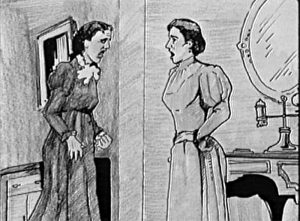
Photoshop and Flash users will be familiar with the visual dynamics, such as superimpositions, zooms, and fades. Filmed re-enactments or simulations tend toward a forced, awkward appearance — an over-used blue-tinted axe, for example. But there are two particularly effective instances of applying original film to pre-existing visuals in the narrative. When the voice-over describes Abby’s last trip up the front stairs, we see a floor-level ascent through the camera lens, which invites us to imagine that fateful, factual trip by the real Abby. Then there is the courtroom scene of the skull-and-hatchet examination; this starts with a representative drawing, which animates into a re-enactment of an axe blade as it is fitted by a hand inside a skull; finally, the huge hole in Abby’s skull becomes a vanishing frame around the head of one of the commentators — a visual fact becoming a transition to a new segment.
The face of Lizzie Borden is never far away in time. There is a continuous search for truth in Lizzie’s persona. One segment begins with a prolonged focus and a slow zoom. For a minute, there is no narrative — only creepy sound effects (orchestral rumblings, meditative strings or bells). This creates an eerie mood, bringing us unexpectedly close to Lizzie, and her image becomes intimate and challenging. Did she or didn’t she? Is this girl as innocent as she appears she could be? What is it that we cannot see?
Each commentator brings a particular point of view or a special branch of knowledge. There is, of course, much subjectivity and speculation in their statements — but none of their opinions are unfounded or irresponsible.
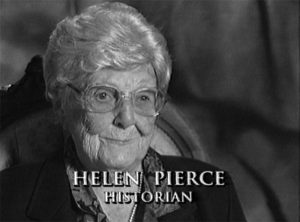 “Her life was not that easy,” Helen Pierce assures us, referring to Lizzie in regard to the primitive lifestyle insisted on by Andrew Borden. Ms. Pierce smiles insightfully through a beautifully lined, ancient face; remembering Lizzie Borden through childhood’s eyes. Speaking of Lizbeth of Maplecroft, she says: “She was very interested in animals all her life. She used to bring her dogs over to Swansee and run them in the fields. And to me she was like somebody’s grandmother. You hear all these stories about how she stared people down and all that kind of thing — well, perhaps they were staring at her. Maybe she had to stare them down — you know what I mean?”
“Her life was not that easy,” Helen Pierce assures us, referring to Lizzie in regard to the primitive lifestyle insisted on by Andrew Borden. Ms. Pierce smiles insightfully through a beautifully lined, ancient face; remembering Lizzie Borden through childhood’s eyes. Speaking of Lizbeth of Maplecroft, she says: “She was very interested in animals all her life. She used to bring her dogs over to Swansee and run them in the fields. And to me she was like somebody’s grandmother. You hear all these stories about how she stared people down and all that kind of thing — well, perhaps they were staring at her. Maybe she had to stare them down — you know what I mean?”
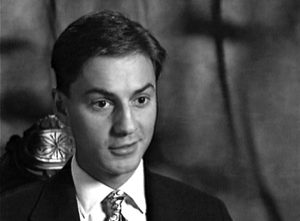 Michael Martins of the Fall River Historical Society is the commentator who gets most of the air time. He emphasizes the mores of Victorian New England – how many of our questions can be answered by an understanding of the inflexible social and ethical codes that confined Lizzie and dictated terms to the investigation. Could Lizzie have made a life for herself outside of her father’s world? Could the police have been more aggressive in subjecting Lizzie to personal searches? “It just was not done,” Martins says, again and again. He ends the documentary with an insightful, speculative quote: “I think that there is no doubt that she was a very strong-willed character. She knew what she wanted, perhaps, did what she needed to get it. However, her life was almost a pathetic one in that she was arrested, she was tried, she was acquitted. Then she was sentenced and lived a life of being ostracized, which is a very difficult thing for any person, certainly. You have to wonder how this would have played on her mind over the years, knowing full well that all of her neighbors – everyone was pointing and talking, and thought that she was guilty. Of course, only she knew, and whether or not she did it, the secret went to her grave. There’s no one left to defend Lizzie Borden.”
Michael Martins of the Fall River Historical Society is the commentator who gets most of the air time. He emphasizes the mores of Victorian New England – how many of our questions can be answered by an understanding of the inflexible social and ethical codes that confined Lizzie and dictated terms to the investigation. Could Lizzie have made a life for herself outside of her father’s world? Could the police have been more aggressive in subjecting Lizzie to personal searches? “It just was not done,” Martins says, again and again. He ends the documentary with an insightful, speculative quote: “I think that there is no doubt that she was a very strong-willed character. She knew what she wanted, perhaps, did what she needed to get it. However, her life was almost a pathetic one in that she was arrested, she was tried, she was acquitted. Then she was sentenced and lived a life of being ostracized, which is a very difficult thing for any person, certainly. You have to wonder how this would have played on her mind over the years, knowing full well that all of her neighbors – everyone was pointing and talking, and thought that she was guilty. Of course, only she knew, and whether or not she did it, the secret went to her grave. There’s no one left to defend Lizzie Borden.”
The Biography of Lizzie Borden has never been written, due to the paucity of information about her. We know no more about her than we do the ancient figures of history. She chose not to reveal herself to the public, and it would appear that this need for privacy, if anything, contributed to the making of the legend. No close friend, if she had one, ever produced an intimate portrait of her. I wonder if she thought that by her silence she was going to eradicate her infamy? Was it humanly possible for her to ever anticipate the magnitude of her current reputation?


